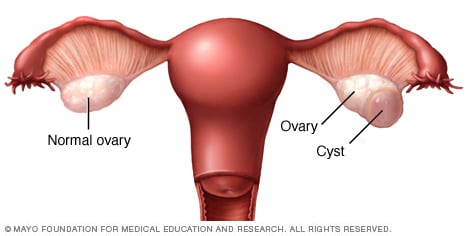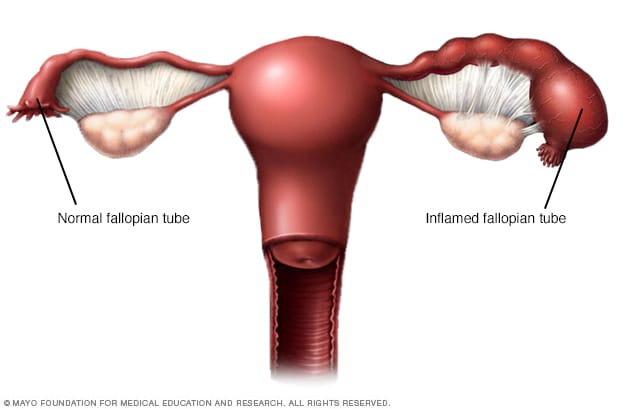Ovarian Cyst
- Common Symptoms: pelvic pain (dull or sharp ache in lower abdomen, on the side of the cyst); fullness/heaviness in abdomen; bloating (Huether & McCance, 2019)
- Pathophysiology: Ovarian cysts are fluid-filled sacs that are found in an ovary or on its surface. They are also called functional cysts, because they are caused by alterations in the normal function of physiologic events. Follicular cysts develop when a dominant, mature follicle is not released with ovulation or when nondominant follicles fail to revert back to original size. Corpus luteum cysts develop when the corpus luteum, produced by granulosa cells after ovulation, does not disintegrate. Lastly, dermoid cysts develop from a buildup of various tissues such as hair, skin, nails, etc. (Huether & McCance, 2019). These cysts usually form unilaterally and are about 5 to 6 cm in diameter.
- Risk Factors: during the reproductive years, especially the extremes (i.e. during puberty or menopause) (Huether & McCance, 2019)
- The patient does have pain in the pelvic area, but it is not unilateral (or on a particular side like it would if the patient had an ovarian cyst). Patient also does not experience fullness/heaviness in the abdomen or bloating. The pain described is not a sudden, severe onset but rather a gradual worsening with each cycle. Also, fever and vomiting are absent when the patient is experiencing pain.

Ovarian Cysts. (2019). Retrieved from https://www.mayoclinic.org/diseases-conditions/ovarian-cysts/symptoms-causes/syc-203534055
Ovarian Cancer
- Common signs/symptoms: persistent abdominal bloating/swelling; quickly feeling full when eating, which can lead to weight loss; discomfort in the pelvis area; changes in bowel habits (e.g. constipation) (Huether & McCance, 2019).
- Pathophysiology: There are two types of ovarian cancers: epithelial ovarian neoplasms and germ-cell neoplasms (Huether & McCance, 2019). However, most cases of ovarian cancer are epithelial ovarian neoplasms. These tumors arise from either activation of oncogenes or the loss of function of tumor-suppressor genes. Germ-cell tumors are much more aggressive. These tumors progress rapidly, and there is usually a poor prognosis (Huether & McCance, 2019).
- Risk Factors: less than 40 years of age has risk for nonepithelial cell tumors; familial history of ovarian cancer (Huether & McCance, 2019).
- The patient does have pain/discomfort in the pelvis area; however, the other symptoms listed above are not present. The patient does not have a familial history of ovarian cancer.

Ovarian Cancer. (2019). Retrieved from https://mayoclinic.org/diseases-conditions/ovarian-cancer/symptoms-causes/syc-20375941
Pelvic Inflammatory Disease
- Common signs/symptoms: sudden, severe bilateral abdominal pain that may worsen with intercourse, walking, or other movements (Huether & McCance, 2019). The pain can also start out as a dull pain and gradually worsen. Other symptoms include pain or difficulty urinating(dysuria), pain with sexual intercourse (dyspareunia), and irregular bleeding. PID might cause only mild signs and symptoms or none at all, usually showing symptoms when PID is severe (Huether & McCance, 2019).
- Pathophysiology: PID is an acute inflammatory disease caused by an infection of the female reproductive organs: usually the organs in the upper genital tract: the uterus, fallopian tubes, or ovaries (Huether & McCance, 2019). Most of these infections are caused by sexually transmitted microorganisms such as chlamydia and gonorrhea.
- The patient has increased uterine bleeding during her menstrual cycle rather than between cycles. The pelvic/abdominal pain is consistent with patient’s symptoms. Patient does note pain during sexual intercourse. Patient does not express pain or difficult urination. There is no notion of multiple sex partners or possible transmission of bacteria through sexual intercourse.

Pelvic Inflammatory Disease. (2019). Retrieved from https://www.mayoclinic.org/diseases-conditions/pelvic-inflammatory-disease/symptoms-causes/syc-20352594
Why Endometriosis Rather than Other Options?
- The symptoms that patient MD is experiencing lines up with the painful dysmenorrhea and dyspareunia that comes with endometriosis (Huether & McCance, 2019). The pain that she is describing is also gradual with each menstrual cycle, which correlates with endometriosis. She also expresses that she has difficulty with conceiving which is also one of the main signs seen with endometriosis rather than ovarian cysts, ovarian cancer, and PID. Patient MD also has a familial history of endometriosis or related symptoms.
- Patient MD’s signs/symptoms do not correlate with ovarian cysts because the abdominal/pelvic pain is not described as unilateral. Patient MD does not express any familial history of ovarian cysts or ovarian cancer. Additionally, it is unlikely that patient MD has PID because the risk of being infected with an STI leading to PID is very low when sexual partners have been monogamous for many years.
